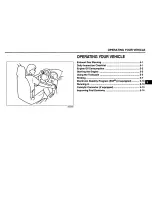
Even though your vehicle is
equipped with TPMS, we
recommend that you visually check
your tires every day. If you think a
tire might be low, check it
immediately with a tire gauge.
Use a gauge to measure the air
pressure in each tire at least once a
month. Even tires that are in good
condition may lose 1 to 2 psi (10 to
20 kPa, 0.1 to 0.2 kgf/cm ) per
month. Remember to check the
spare tire at the same time.
Check the air pressures when the
tires are cold. This means the
vehicle has been parked for at least 3
hours, or driven less than 1 mile (1.6
km). Add or release air, if needed, to
match the recommended cold tire
pressures on the next page.
If you check air pressure when the
tires are hot [driven for several miles
(kilometers)], you will see readings 4
to 6 psi (30 to 40 kPa, 0.3 to 0.4
kgf/cm ) higher than the cold
readings. This is normal. Do not let
air out to match the recommended
cold air pressure. The tire will be
underinflated.
While tubeless tires have some
ability to self-seal if they are
punctured, you should look closely
for punctures if a tire starts losing
pressure.
You should get your own tire
pressure gauge and use it whenever
you check your tire pressures. This
will make it easier for you to tell if a
pressure loss is due to a tire problem
and not due to a variation between
gauges.
Tires
Ma
int
e
na
nce
569
12/07/20 11:43:24 31TK4640_574
Summary of Contents for 2014 TL
Page 66: ...60 12 07 20 10 37 25 31TK4640_065 ...
Page 230: ...224 12 07 20 10 58 17 31TK4640_229 ...
Page 472: ...466 12 07 20 11 30 44 31TK4640_471 ...
Page 586: ...580 12 07 20 11 44 56 31TK4640_585 ...
Page 640: ...634 12 07 20 11 51 41 31TK4640_639 ...
Page 651: ... XM Radio 246 299 U S Index INDEX X XI 12 08 03 21 02 39 31TK4640_650 ...
Page 652: ...12 07 20 11 52 36 31TK4640_652 ...
















































